Headers and Footers
Welcome to the 'Headers and Footers' section! These elements, located at the top and bottom of pages, provide a canvas for titles, chapter details, page numbers, and more. Delve into the world of customization, where you can control their appearance, content, and arrangement.
Introduction
In LaTeX documents, headers and footers offer a means to add essential information, such as page numbers, document titles, or chapter names, to every page consistently. They provide a structured framework for presenting crucial details, enhancing readability, and maintaining a professional appearance.
Standard page styles
LaTeX offers several page styles, each serving different formatting purposes. Common styles include:
| Style | Header | Footer |
|---|---|---|
empty | No header | No footer |
plain | No header | Centered page number |
headings | Displays information according to document class (e.g., section name or chapter title) and a centered page number. | No footer |
myheadings | Contains page number and allows users to specify custom content for headers. | No footer |
Default page styles in standard document classes
Each document class has its predefined default page style, determining the layout and content of headers and footers in LaTeX documents. The following table represent the initial setup for headers and footers in standard LaTeX document classes:
| Document Class | Default Page Style |
|---|---|
article | plain |
report | plain |
book | headings |
letter | empty |
You can, however, modify these styles using commands or packages to suit your specific requirements.
Setting page styles
In standard LaTeX, the options for changing headers and footers are rather restricted. There are only two commands available:
\pagestyle{<style>}→ Sets the style for the the current and all subsequent pages.\thispagestyle{<style>}→ Sets the style for the current page only.
Setting the content of headers
You can manually set the content of the headers using the following commands:
-
\markboth{left content}{right content}→ Sets both the left and right content of the header on the current page.
For example:\markboth{Section Name}{Book Name} % This command will set "Section Name" on the left side and "Book Name" on the right side of the header. -
\markright{right content}→ Sets the right content of the header on the current page.
For example:\markright{Chapter 1} % This command will set "Chapter 1" on the right side of the header.
By using these commands you can override the default behavior of displaying section names or chapter titles automatically. They provide flexibility in customizing the header content according to your preferences.
LaTeX commands for dynamic header and footer content
In LaTeX, specific commands allow for dynamic content insertion into headers and footers, enabling the display of information like page numbers, chapter or section titles, and their respective numbers according to the structure of the document:
-
\thepage
Represents the current page number. -
\leftmark
Prints current chapter name. -
\rightmark
Prints current section name.
\leftmark and \rightmark hold information set by \markboth and \markright commands.
-
\chaptername
Displays the term for "chapter" in the document's language. (e.g. in English, it will prints "Chapter") -
\thechapter
Represents the current chapter number. -
\thesection
Represents the current section number.
| Command | Description |
|---|---|
\thepage | Represents the current page number. |
\leftmark | Prints current chapter name. |
\rightmark | Prints current section name. |
\chaptername | Displays the term for "chapter" in the document's language. (e.g. in English, it will prints "Chapter") |
\thechapter | Represents the current chapter number. |
\thesection | Represents the current section number. |
Using fancyhdr package
In LaTeX, headers and footers can be created using the fancyhdr package. This package provides a set of commands for customizing the headers and footers, including the ability to specify the contents of the header and footer, the font style, and the horizontal and vertical position.
Key fancyhdr commands for customizing headers and footers
The fancyhdr package in LaTeX offers various commands to customize headers and footers. Some of the most commonly used commands include:
-
fancyhead→ Set content for the header.\fancyhead[placement]{content}placement: Specifies the position in the header (e.g. L, C, or R for left, center, or right).content: Refers to the text or elements to be placed in the specified header position.
-
fancyfoot→ Set content for the footer.
\fancyfoot[placement]{content}
\fancyhf→ Set content for both the header and footer simultaneously by merging\fancyheadand\fancyfootfunctionalities.
\fancyhf[locations]{content}
You can also specify positions for the header or footer fields (using H for header or F for footer). If omitted, it sets the fields for both the header and footer.
The command \fancyhf{} alone without any arguments or parameters is used to clear the existing header and footer configurations. It essentially resets both the header and footer to be empty, erasing any previously set content or formatting, including text, page numbers, lines, or any other elements in the header and footer sections.
\lhead,\chead,\rhead→ Set left, center, and right content for the header.
\lhead{content}
\chead{content}
\rhead{content}
\lfoot,\cfoot,\rfoot→ Set left, center, and right content for the footer.
\lfoot{content}
\cfoot{content}
\rfoot{content}
Position selectors for customization of headers and footers
The fancyhead and fancyfoot commands in LaTeX accept selectors as arguments to determine the position of the header or footer text on the page:
L→ leftC→ centerR→ rightE→ even pageO→ odd page
By combining these selectors, you can precisely position text or elements within the header or footer. For example:
\fancyhead[LE,RO]{\thepage}
The above command will place the page number on the left for even pages and on the right for odd pages in the header.
The diagram below outlines the arrangement of headers and footers and their selectors in a single-sided document:
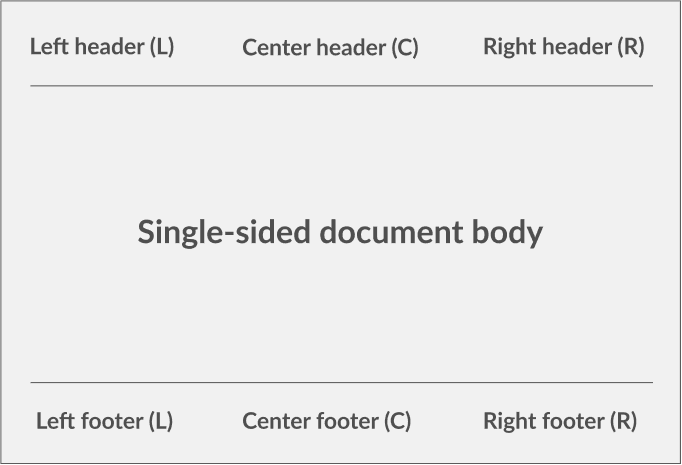
And the following diagram shows the placement of headers and footers in a two-sided document:
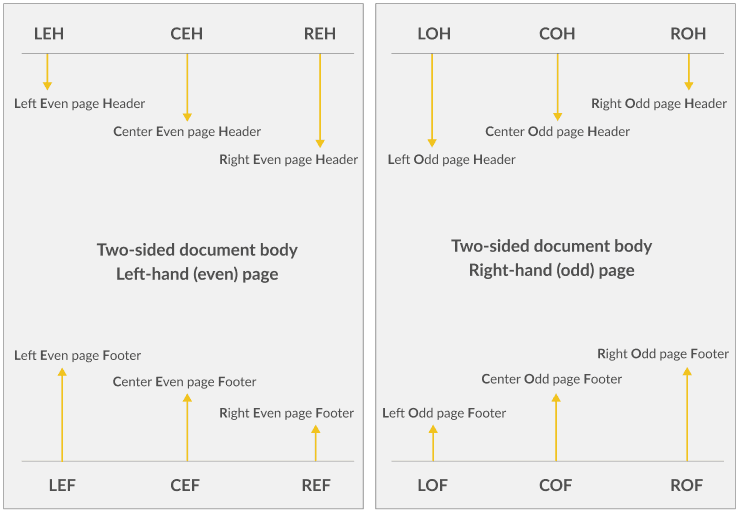
Here's an example of how to create a simple header and footer using the fancyhdr package:
\documentclass{book}
\usepackage{blindtext}
\usepackage{fancyhdr}
\pagestyle{fancy}
\fancyhead[L]{\LaTeX guides and tutorials}
\fancyhead[R]{TexReady}
\fancyfoot[L]{\today}
\fancyfoot[C]{\thepage}
\begin{document}
\blindtext[5]
\end{document}
This example generates the following output:
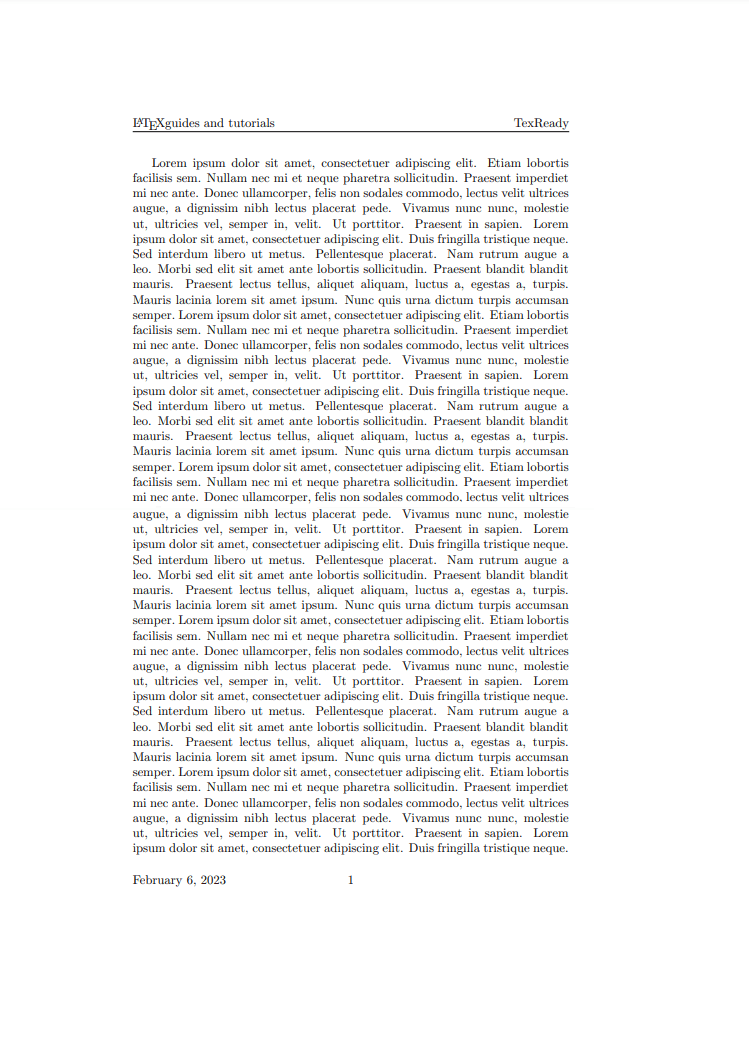
Description:
\documentclass{book}→ declares that the document class is a book.\usepackage{blindtext}→ imports the blindtext package, which provides dummy text to be used in the document.\usepackage{fancyhdr}→ imports the fancyhdr package, which provides the capability to customize headers and footers.\pagestyle{fancy}→ sets the pagestyle of the document to fancy, which enables the customization of headers and footers.\fancyhead[L]{\LaTeX guides and tutorials}→ sets the left header to the text "LaTeX guides and tutorials".\fancyhead[R]{TexReady}→ sets the right header to the text "TexReady".\fancyfoot[L]{\today}→ sets the left footer to the current date using\todaycommand.\fancyfoot[C]{\thepage}→ sets the center footer to the current page number using\thepagecommand.
Here's another example of how you might use each selector in the fancyhead and fancyfoot commands:
\documentclass{book}
\usepackage{blindtext}
\usepackage{fancyhdr}
\pagestyle{fancy}
\fancyhead[L]{Left header}
\fancyhead[C]{Center header}
\fancyhead[R]{Right header}
\fancyfoot[L]{Left footer}
\fancyfoot[C]{Center footer}
\fancyfoot[R]{Right footer}
\begin{document}
\blindtext[5]
\end{document}
This example generates the following output:
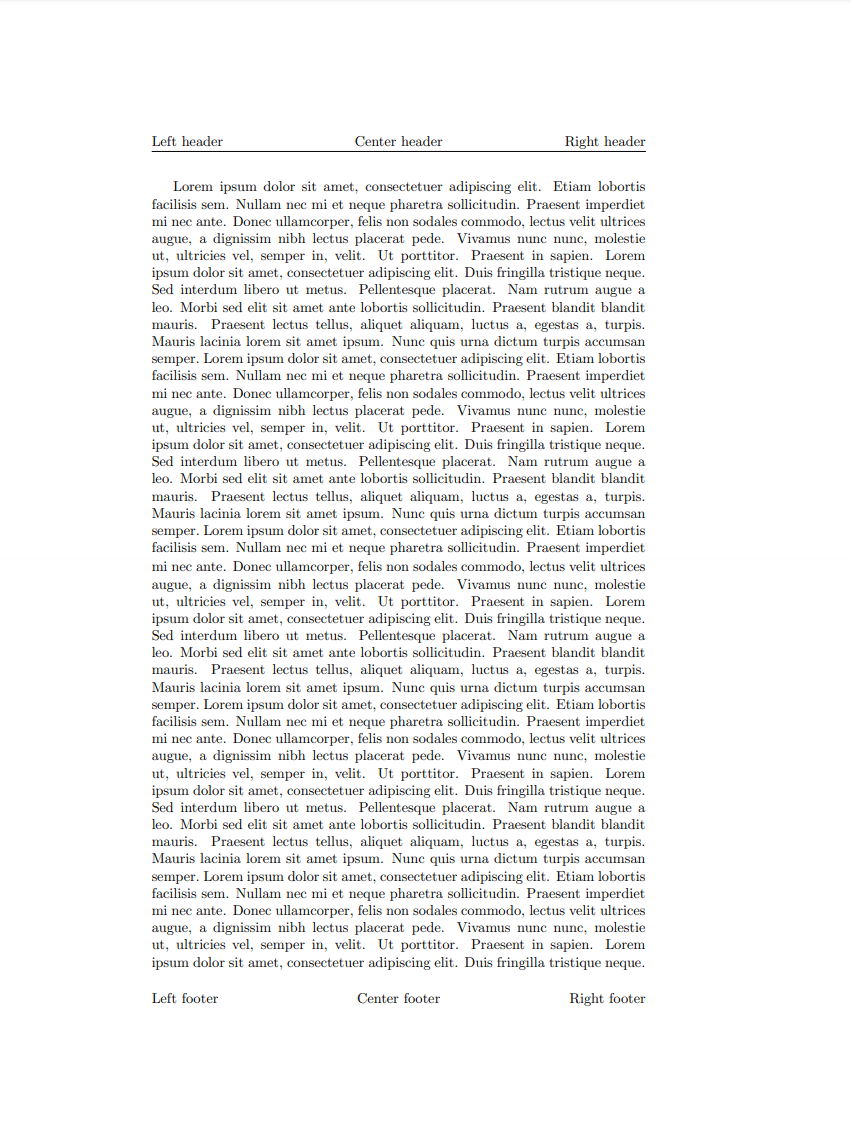
The above example would produce a document with a left, center and right header and footer.
The E and O selectors are used to set different headers or footers for even and odd pages. For two-sided documents, such as books or double-sided printing, you can specify different headers and footers for odd and even pages. Here's an example:
\documentclass[twoside]{book}
\usepackage{blindtext}
\usepackage{fancyhdr}
\pagestyle{fancy}
\fancyhead[LE,RO]{\leftmark}
\fancyhead[RE,LO]{\thepage}
\fancyfoot[C]{\today}
\begin{document}
\chapter{Introduction}
\section{Section 1}
\blindtext[15]
\end{document}
This example generates the following output:
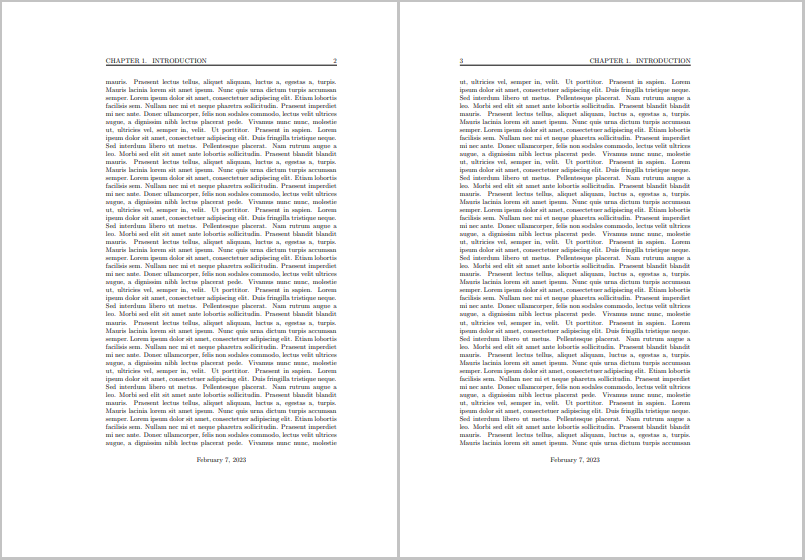
Description:
-
\documentclass[twoside]{book}→ This line specifies that the document is a book and it will be typeset with two-sided layout. -
\usepackage{fancyhdr}→ This line loads the fancyhdr package, which provides the necessary tools for creating custom headers and footers. -
\pagestyle{fancy}→ This line sets the page style to fancy, which means that the headers and footers will be set according to the specifications provided in the following lines. -
\fancyhead[LE,RO]{\leftmark}→ This line sets the current section title to be displayed on the left-hand side of even pages and the right-hand side of odd pages. -
\fancyhead[RE,LO]{\thepage}→ This line sets the page number to be displayed on the right-hand side of even pages and the left-hand side of odd pages. -
\fancyfoot[C]{\today}→ This line sets the current date to be displayed at the bottom center of every page. -
\blindtext[15]→ This line generates dummy text to fill the page.